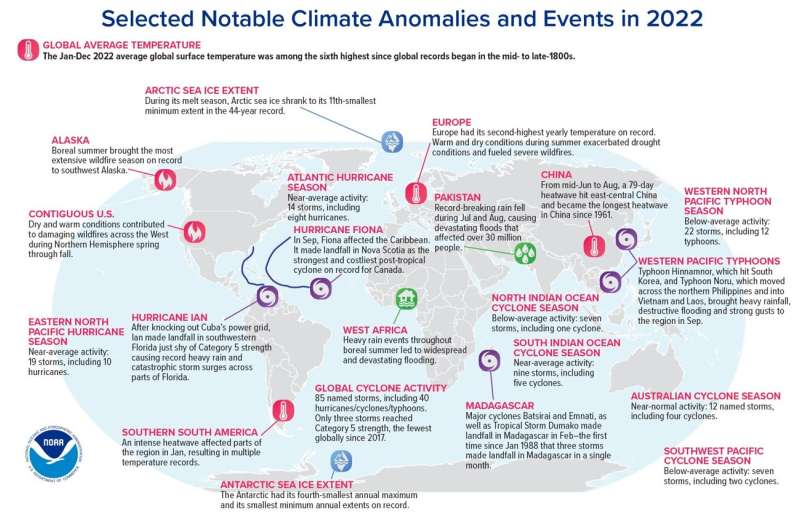
Greenhouse gas concentrations, global sea level and ocean heat content reached record highs in 2022, according to the 33rd annual State of the Climate report.
“People are causing the largest known change in global climate since our transition to agriculture thousands of years ago,” said Paul Higgins, associate executive director of the American Meteorological Society. “The State of the Climate in 2022 report—an ongoing collaboration between NOAA and AMS—helps us understand the climate system, the impact people are having on climate, and the potential consequences. The report can help inform the decisions needed to enable humanity and all life to thrive for generations to come.”
Notable findings from the international report include:
- Earth’s greenhouse gas concentrations were the highest on record. Carbon dioxide, methane and nitrous oxide—Earth’s major atmospheric greenhouse gases—once again reached record high concentrations in 2022. The global annual average atmospheric carbon dioxide concentration was 417.1 parts per million (ppm). This was 50% greater than the pre-industrial level, 2.4 ppm greater than the 2021 amount, and the highest measured amount in the modern observational records as well as in paleoclimatic records dating back as far as 800,000 years. The annual atmospheric methane concentration also reached a record high, which was a 165% increase compared to its pre-industrial level and an increase of about 14 parts per billion (ppb) from 2021. The annual increase of 1.3 ppb for nitrous oxide in 2022, which was similar to the high growth rates in 2020 and 2021, was higher than the average increase during 2010–19 (1.0 ± 0.2 ppb), and suggests increased nitrous oxide emissions in recent years.
- Warming trends continued across the globe. All six major global temperature datasets used for analysis in the report agree that the last eight years (2015–22) were the eighth warmest on record. Even though the year ranked among the six warmest years on record, the presence of La Nina in the Pacific Ocean had a cooling effect on the 2022 global temperatures in comparison to years characterized by El Nino or neutral El Nino–Southern Oscillation (ENSO) conditions.
- Ocean heat and global sea level were the highest on record. Over the past half-century, the oceans have stored more than 90% of the excess energy trapped in Earth’s system by greenhouse gases and other factors. The global ocean heat content, measured from the ocean’s surface to a depth of 2,000 meters (approximately 6,561 ft), continued to increase and reached new record highs in 2022. Global mean sea level was record high for the 11th-consecutive year, reaching about 101.2 mm (4.0 inches) above the 1993 average when satellite altimetry measurements began.
- Heat waves shattered temperature records across the planet. In July, a 14-day heat wave swept through western Europe. A weather station in England recorded a temperature of 104 degrees F (40 degrees C) for the first time ever, over 100 stations in France broke all-time temperature records, and stations in at least six other European countries set all-time heat records. The extreme high summer temperatures over Europe resulted in unprecedented melting of glaciers in the Alps, with over 6% of their volume—a record loss—lost in Switzerland in 2022 alone. Record-breaking summer heat in central and eastern Asia, particularly in the Yangtze River basin, led to a devastating drought that affected more than 38 million people and caused a direct economic loss of $4.75 billion U.S. dollars.
- The Arctic was warm and wet. The Arctic had its fifth-warmest year in the 123-year record. 2022 marked the ninth-consecutive year that Arctic temperature anomalies were higher than the global mean anomalies, providing more evidence of the process known as Arctic amplification in which physical processes cause the Arctic to warm more quickly than the rest of the planet. The seasonal Arctic minimum sea-ice extent, typically reached in September, was the 11th-smallest in the 43-year record. The amount of multiyear ice—ice that survives at least one summer melt season—remaining in the Arctic continued to decline. Since 2012, the Arctic has been nearly devoid of ice that is more than four years old. Annual average Arctic precipitation for 2022 was the third-highest total since 1950, and three seasons (winter, summer and autumn) ranked among the 10 wettest for their respective season.